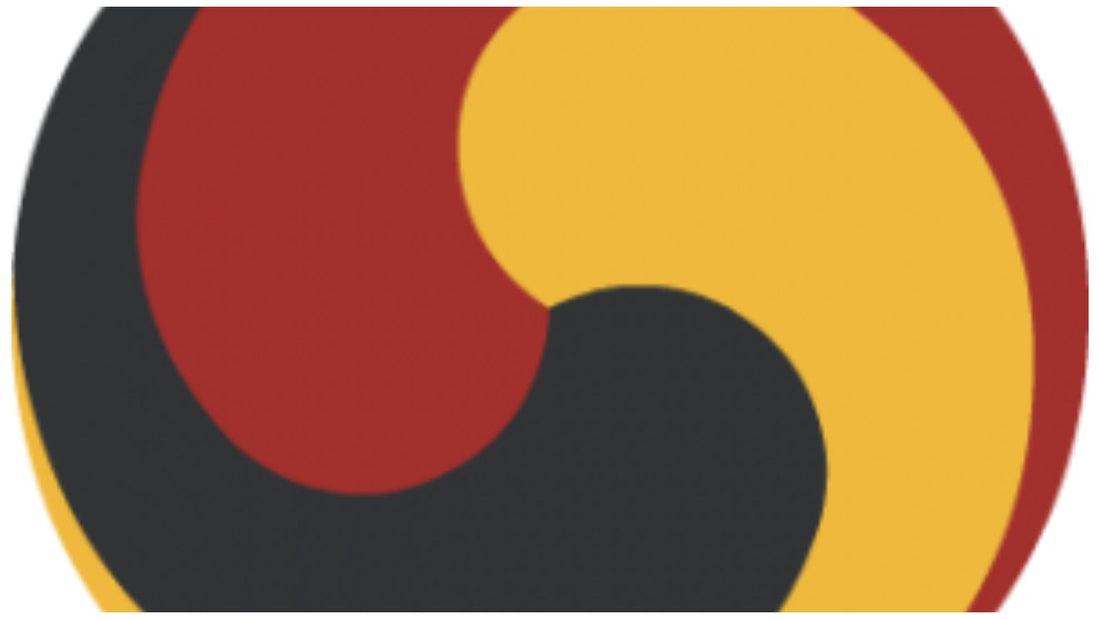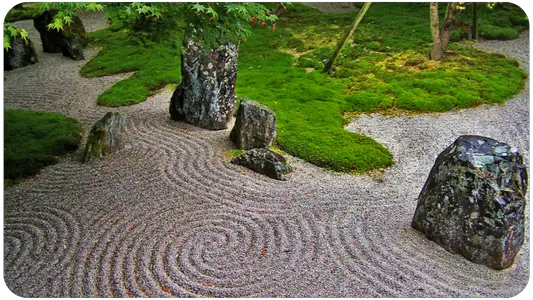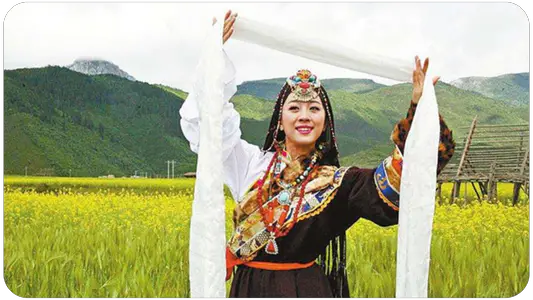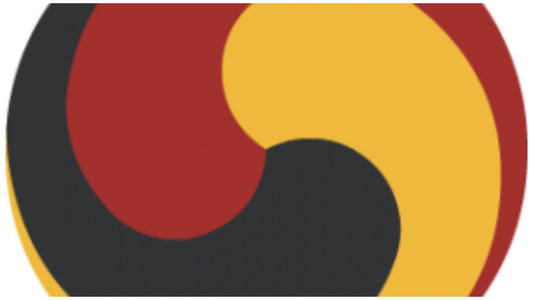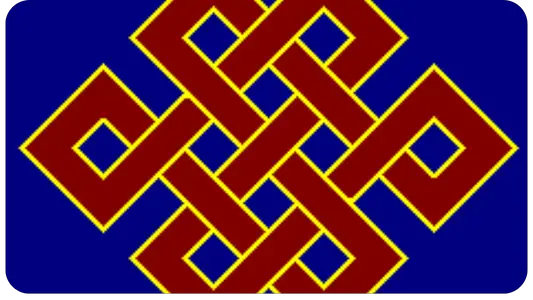The Gankyil ( Tibetan: དགའ་འཁྱིལ། Lhasa IPA: [/kã˥ kʲʰiː˥/]) or "wheel of joy" (Sanskrit: ānanda-cakra) is a symbol and ritual tool used in Tibetan Buddhism and East Asian Buddhism.
It consists of three (sometimes two or four) rotating and interconnected blades. The traditional direction of rotation is clockwise (right-hand spin), but counterclockwise directions are also common.
The gankyil as the inner wheel of the dharmachakra is depicted on the flag of Sikkim, the Joseon Dynasty, the flag of Tibet and the emblem of Tibet.Associated triads
Soil, path and fruit.
"ground", "ground" ( Tibetan: གཞི།, Wylie: gzhi).
"way", "method" (Tibetan: ལམ།, Wylie: lam).
"fruit", "product" (Tibetan: འབྲས།, Wylie: 'bras).
Three humors of traditional Tibetan medicine.
Attributes related to the three humors (Sanskrit: tridoshas, Tibetan: nyi pa gsum ):
Desire (Tibetan: འདོད་ཆགས། 'dod chags ) is aligned with the mood Wind ( Sanskrit: vata - "constitution of air and ether").
Hatred (Tibetan: ཞེ་སྡང་་། zhe sdang) is aligned with mood Bile (Tripa, Tibetan: མཁྲིས་པ། mkhris pa, Sanskrit: pitta - "constitution of fire and water")
Ignorance (Tibetan: གཏི་མུག gti mug) is aligned with the mood Phlegm (Tibetan beken: བད་ཀན།bad kan, Sanskrit: kapha - "earth and water constitution").
Study, reflection and meditation.
Study ( Tibetan : ཐོས་པ། thos + pa ).
Reflection ( Tibetan : བསམ་པ། sam + pa )
Meditation ( Tibetan : སྒོམ་པ། sgom pa ).
These three aspects are the mūla prajñā of the sādhanā of the prajñāpāramitā, the "pāramitā of wisdom". Thus, these three are related to, but distinct from, the Prajñāpāramitā which denotes a particular cycle of discourse in Buddhist literature that relates to the doctrinal field ( kṣetra ) of the second turn of the dharmacakra.
Dharmas of the path
The Dzogchen teachings focus on three terms:
Vision (Tibetan: ལྟ་བ། lta-ba ),
Meditation (Tibetan: སྒོམ་པ། sgom pa ),
Action (Tibetan: སྤྱོད་པ། spyod-pa ).
Triratna Doctrine
The Triratna, the Triple Jewel or the Three Gems are triune, therefore, they are represented by the Gankyil:
Buddha (Tibetan: སངས་རྒྱས།, Sangye, Wyl. sangs rgyas).
Dharma (Tibetan: ཆོས།, Cho; Wyl. chos)
Sangha (Tibetan: དགེ་དུན།, Gendun; Wyl. dge 'dun)
Three Roots
The Three Roots are:
Guru (Tibetan: བླ་མ།, Wyl. bla ma).
Yidam (Tibetan: ཡི་དམ།, Wyl. yi dam; Skt. istadevata)
Dakini (Tibetan: མཁའ་འགྲོ་མ།, Khandroma; Wyl. mkha 'gro ma).
Three Higher Trainings
The Three Higher Trainings (Tibetan: ལྷག་བའི་བསླབ་པ་གསུམ་, lhagpe labpa sum, or Wyl. bslab pa gsum)
discipline (Tibetan: ཚུལ་ཁྲིམས་ཀྱི་བསླབ་པ།, Wyl. tshul khrims kyi bslab pa)
meditation (Tibetan: ཏིང་ངེ་འཛན་གྱི་བསླབ་པ།, Wyl. ting nge 'dzin gyi bslab pa)
wisdom (Tibetan: ཤེས་རབ་ཀྱི་བསླབ་པ།, Wyl. shes rab kyi bslab pa)
Three Dharma Seals
The indivisible essence of the Three Dharma Seals (ལྟ་བ་བཀའ་རྟགས་ཀྱི་ཕྱག་རྒྱ་གསུམ།) is embodied and encoded within the Gankyil:
Impermanence (Tibetan: འདུ་བྱེ་ཐམས་ཅད་མི་རྟག་ཅིང་།)
anatta (Tibetan: ཆོས་རྣམས་སྟོང་ཞིང་བདག་མེད་པ།)
Nirvana (Tibetan: མྱང་ངན་འདས་པ་ཞི་བའོ།།)
Three turns of the Wheel of Dharma
As the inner wheel of the Vajrayana Dharmacakra, the gankyil also represents the syncretic union and embodiment of Gautama Buddha's Three Turns of the Wheel of Dharma. The upaya pedagogical doctrine and the classification of the "three turns of the wheel" was first postulated by the Yogacara school.
Trikaya Doctrine
Gankyil is the energetic signature of the Trikaya, realized through the transmutation of the obscurations crossed by the Three poisons (refer to klesha) and therefore in Bhavachakra Gankyil is an aniconic representation of the snake, the boar and the bird.
Gankyil is to Dharmachakra, what stillness is to cyclone, as Bindu is to Mandala. Gankyil is the inner wheel of the Vajrayana Dharmacakra (refer to Ashtamangala).
The Gankyil is a symbol of the Trikaya doctrine of dharmakaya (Tibetan:ཆོས་སྐུ།, Wyl. Chos sku), sambhogakaya (Tibetan:ལོངས་སྐུ་ Wyl. longs sku) and nirmanakaya (Tibetan:སྤྲུལ་སྐུ། Wyl.sprul sku) and also from the Buddhist understanding of the interdependence of the Three Vajras : of mind, voice and body.
The divisions of Dzogchen's teaching are for explanation purposes only; just as the divisions of Gankyil are understood to dissolve in the energetic whirlwind of the Wheel of Joy .
Three cycles of Nyingmapa Dzogchen
The Gankyil also embodies the three cycles of Nyingma Dzogchen encoded by Mañjuśrīmitra :
Semde [Tibetan: སེམས་སྡེེ།]
Longdé [Tibetan: ཀློང་སྡེ།]
Mengagde [Tibetan: མན་ ངག་ སྡེ།]
This classification determined the exposition of the Dzogchen teachings in later centuries.
Three spheres
"Three spheres" (Sanskrit: trimandala; Tibetan: འཁོར་གསུམ།'khor gsum). The conceptualizations relating to:
Subject
Object
Action
Sound, light and rays.
The triune continuum of the esoteric Dzogchen doctrine of 'sound, light and rays' (སྒྲ་འོད་ཟེར་གསུམ། Wylie: sgra 'od zer gsum) is maintained within the energetic signature of the Gankyil. The doctrine of 'Sound, Light and Rays' is intimately related to the Dzogchen teaching of the 'three aspects of energy manifestation'.
Although completely interpenetrated and non-localized, 'sound' can be understood to reside in the heart, the 'mind' wheel; 'light' in the throat, the 'voice' wheel; and 'rays' in the head, the 'body' wheel.
Some Dzogchen lineages, for various purposes place 'rays' on the Ah wheel (for pranayama of the Five Pure Lights) and 'light' on the Aum wheel (for the rainbow body), although there are other enumerations.
Three lineages of Nyingmapa Dzogchen
The Gankyil also embodies the three tantric lineages as stated by Penor Rinpoche, a Nyingmapa :
According to the origin story of the tantras there are three lineages:
The Buddha Intention Lineage, which refers to the teachings of the Body of Truth that originated from the primordial Buddha Samantabhadra, who is said to have taught tantras to an assembly of fully enlightened beings emanating from the Body of Truth itself.
Therefore, this level of teaching is considered completely beyond the reach of ordinary human beings.
The Lineage of the Possessors of Knowledge corresponds to the teachings of the Body of Delight originating from Vajrasattva and Vajrapani, whose human lineage begins with Garab Dorje of the Ögyan Dakini land.
From him the lineage passed to Manjushrimitra, Shrisimha and then to Guru Rinpoche, Jnanasutra, Vimalamitra and Vairochana who disseminated it in Tibet.
Finally, the Human Whispered Lineage corresponds to the teachings of the Emanation Body, which originate from the Five Buddha Families.
They were passed on to Shrisimha, who transmitted them to Guru Rinpoche, who by giving them to Vimalamitra initiated the lineage that has continued in Tibet to this day.
Three aspects of energy in Dzogchen
The Gankyil also embodies the energy manifested in the three aspects that produce the energetic arising (Tibetan: རང་བྱུན། rang byung ) of phenomena (Tibetan: ཆོས་ Wylie: "chos" Sanskrit: dharmas ) and sentient beings (Tibetan: ཆོས་ : ཡིད་ཅན། yid can):
dang (གདངས། Wylie: gDangs ), this is an infinite and formless level of compassionate energy and reflective capacity, it is "a consciousness free of restrictions and as an energy free of any boundary or form."
rolpa (རོལ་པ། Wylie: Rol-pa ). These are manifestations that appear to be internal to the individual (as when a crystal ball appears to reflect something within itself).
tsal (རྩལ། Wylie: rTsal, is "the manifestation of the energy of the individual himself, as an apparently 'external' world," although this apparent externality is only "a manifestation of our own energy, at the level of Tsal." This is explained by the use of a crystal prism that reflects and refracts white light into various other forms of light.
Although not discrete correlates, dang equals dharmakaya ; rolpa equals sambhogakaya ; and tsal equals nirmanakaya .
Three treasures of Yungdrung Bon
In the Bon, gankyil denotes the three main terma cycles of Yungdrung Bon: the Northern Treasury ( Wylie: byang gter), the Central Treasury ( Wylie: dbus gter) and the Southern Treasury ( Wylie: lho gter).
The Northern Treasury is compiled from texts revealed in Zhangzhung and northern Tibet, the Southern Treasury from texts revealed in Bhutan and southern Tibet, and the Central Treasury from texts revealed in Ü-Tsang near Samye.
The gankyil is the central part of the shang (Tibetan: gchang), a traditional tool and ritual instrument of the Bönpo shaman.

